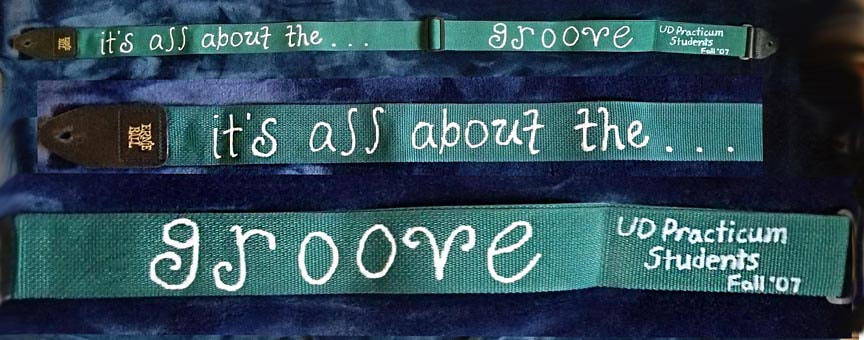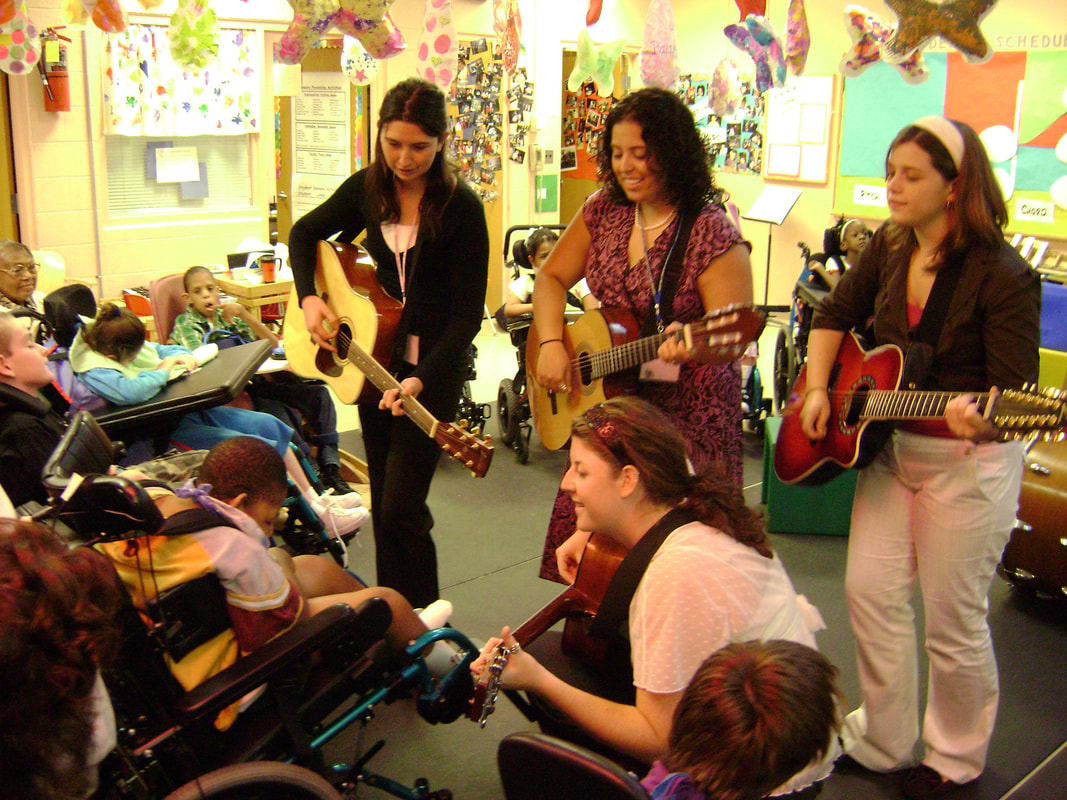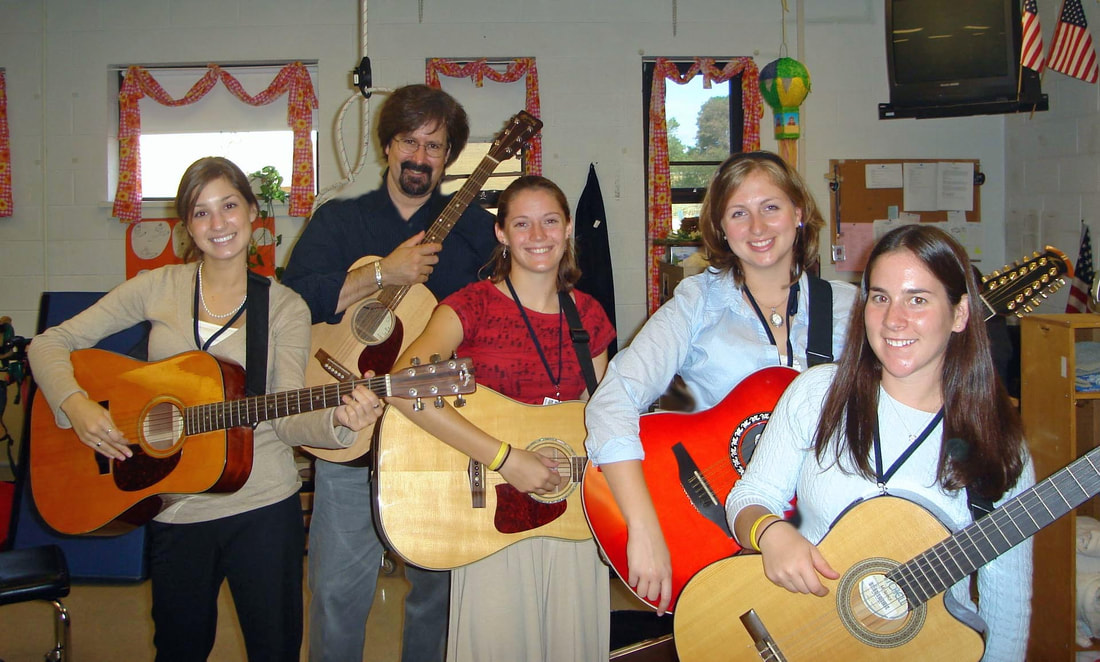The second dirty little secret about guitar playing if you're a music teacher is that you'll never have to be Dan Graper, Nick Bucci, or Eddie Van Halen. It would be nice to be able to play those incredible solos like Dan, Nick, and Eddie but don't fret. It won't be necessary for you to learn how to improvise elaborate single-note lines. It’s an admirable skill but would be misplaced effort on your part – you need to groove, not solo. From where you're going to be standing, it’s all about the groove.
If you need a guitar solo, call Nick or Dan.
Once you can strum in rhythm, down and up, without thinking while you sing, you need to take the next step: make the guitar sound more like a drum set.
Your role as a guitar player will be to provide a steady groove. That could be the sound of two sticks clicking together (dull and simplistic) or like a whole drum set (interesting and complex). The goal is to approximate a sound that simultaneously provides the groove of a drum set and harmony of a piano.
Your strumming patterns should always sound like some combination of a kick drum, a snare drum, a hi-hat, and occasionally a crash the primary cymbal. The low strings of the guitar are your kick. The middle strings create more of the snap of the snare drum on two and four while leaving beats one and three for the kick. The higher strings give the sense of hi-hats or cymbals.
Making the guitar resemble the feel of a drum set is an indispensable technique to develop on guitar. Once you can approach that, you start to try and sound like different drummers. Or even a drum machine loop. The possibilities are endless.
Always focus on allowing the groove and the rhythm have something to do with the previous measures. Record yourself often, study your recordings, make adjustments, and make sure that the last measure of every phrase helps lead into the next phrase.
The prime directive is to “Never Let the Groove” die. That doesn't mean you can't pause, thin the texture, or put rests in what you're playing. It simply means that should you modify your strumming pattern or stop strumming completely, the listener can still hear the groove in their head that you just played in the last two measures. When your playing comes in full again, you come in at the exact right time with the exact same point in the groove that you established 10 seconds before.
Once you get the drum set feel going, start moving out of basic cowboy chords and try different inversions further down the neck. Y.A.H.O.O. - You always have options: you can play every chord in at least four different locations on the neck.
Your value as a music teacher will grow exponentially with guitar skills. You’ll be able to “work the room” more effectively if you can make “mobile music”. Don’t put it off. Start today.
I’ll leave you with a great guitar and teaching memory of mine.
In 2007, my principal Jack Jadach graciously allowed University of Delaware Music Department practicum students to study at our school, the John G. Leach School. When I found out the college students didn’t have any guitars, I brought four guitars from my “posse” of guitars at home for them to use – and held my breath that these guitars would hold up under the rigors of both beginning players as well as Leach School.
The ladies were fantastic with our students and were quick studies. The kids loved all of them. Each week, I kept making the U of D students focus on their right hand technique and the groove. They presented me with this “thank you” guitar strap on their last day.
It’s all about the groove . . . and you.
If you need a guitar solo, call Nick or Dan.
Once you can strum in rhythm, down and up, without thinking while you sing, you need to take the next step: make the guitar sound more like a drum set.
Your role as a guitar player will be to provide a steady groove. That could be the sound of two sticks clicking together (dull and simplistic) or like a whole drum set (interesting and complex). The goal is to approximate a sound that simultaneously provides the groove of a drum set and harmony of a piano.
Your strumming patterns should always sound like some combination of a kick drum, a snare drum, a hi-hat, and occasionally a crash the primary cymbal. The low strings of the guitar are your kick. The middle strings create more of the snap of the snare drum on two and four while leaving beats one and three for the kick. The higher strings give the sense of hi-hats or cymbals.
Making the guitar resemble the feel of a drum set is an indispensable technique to develop on guitar. Once you can approach that, you start to try and sound like different drummers. Or even a drum machine loop. The possibilities are endless.
Always focus on allowing the groove and the rhythm have something to do with the previous measures. Record yourself often, study your recordings, make adjustments, and make sure that the last measure of every phrase helps lead into the next phrase.
The prime directive is to “Never Let the Groove” die. That doesn't mean you can't pause, thin the texture, or put rests in what you're playing. It simply means that should you modify your strumming pattern or stop strumming completely, the listener can still hear the groove in their head that you just played in the last two measures. When your playing comes in full again, you come in at the exact right time with the exact same point in the groove that you established 10 seconds before.
Once you get the drum set feel going, start moving out of basic cowboy chords and try different inversions further down the neck. Y.A.H.O.O. - You always have options: you can play every chord in at least four different locations on the neck.
Your value as a music teacher will grow exponentially with guitar skills. You’ll be able to “work the room” more effectively if you can make “mobile music”. Don’t put it off. Start today.
I’ll leave you with a great guitar and teaching memory of mine.
In 2007, my principal Jack Jadach graciously allowed University of Delaware Music Department practicum students to study at our school, the John G. Leach School. When I found out the college students didn’t have any guitars, I brought four guitars from my “posse” of guitars at home for them to use – and held my breath that these guitars would hold up under the rigors of both beginning players as well as Leach School.
The ladies were fantastic with our students and were quick studies. The kids loved all of them. Each week, I kept making the U of D students focus on their right hand technique and the groove. They presented me with this “thank you” guitar strap on their last day.
It’s all about the groove . . . and you.



 RSS Feed
RSS Feed